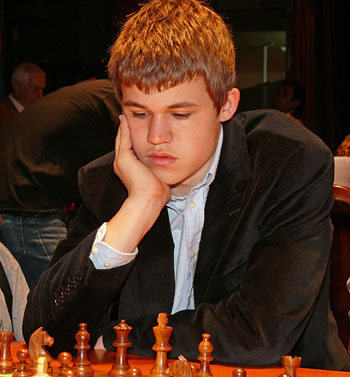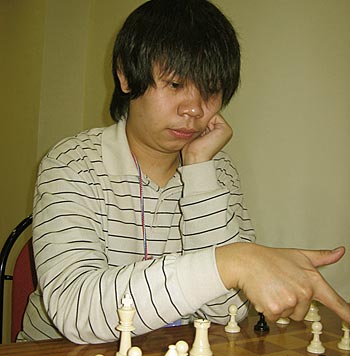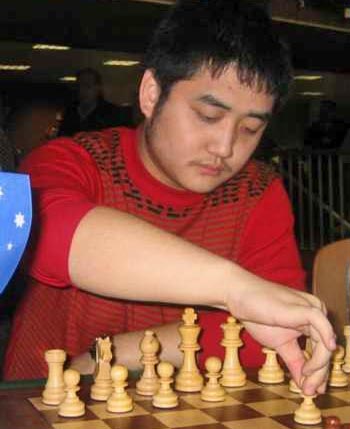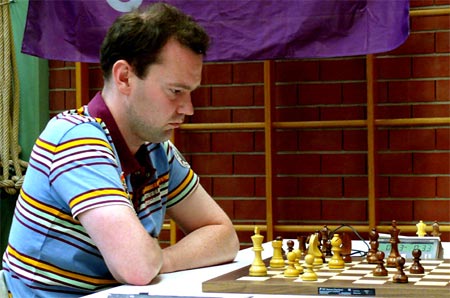| Latest | Greatest | Lobby | Journals | Search | Options | Help | Login |
|
|
|
This topic is archived. |
| Home » Discuss » Topic Forums » Sports |
|
| Jack Rabbit
|
Sat Mar-15-08 02:53 AM Original message |
| The Jack Rabbit Chess Report (March 15): Hou Yifan leads in Istanbul |
|
Reykjavik Open finishes in three-way tie
 Two Chinese grandmasters, Wang Hao and Wang Yue, and Icelandic GM Hannes Stefansson finished tied for first place with 7 points each out of nine rounds in the Reykjavik Open completed last Tuesday. Wang Hao was declared the tournament champion on tie break points. Hannes and Wang Yue share second place. Fifteen-year-old Fabiano Caruana, the American-born national champion of Italy, who led the tournament at the halfway mark, finished tied for fourth with 6� points. Former women�s world champion Antoaneta Stefanova of Bulgaria had the highest score among women players in the event with 6 points. Wang Yue finished with the most victories in the tournament with 6. Wang Yue was upset in the opening round by Bjorn Thorfinnsson, a federation master from Iceland who doubled as tournament organizer. Wang Yue then won his next five games in a row, drew in rounds seven and eight and scored a victory in the final round over Greek grandmaster Stelios Halkias to secure a share of first place and Wang Hao and Hannes played each other to a draw. Hou Yifan leads Women Masters� Tournament in Istanbul  Ten women are competing in the Women Masters� Tournament that began Tuesday in Istanbul. The women are: Zhu Chen, formerly of China and presently of Qatar; Hou Yifan, the 14-year-old phenomenon from China; grandmaster Pia Cramling of Sweden, a pillar of women�s chess for a quarter century; international master Zhao Xue from China; Anna Usheinina of Ukraine; international master Irina Krush, the reigning US women�s champion; international master Lela Javakishvili of Georgia; seventeen-year-old IM Dronavalli Harika of India; international master Ekaterina Atalik, the Russian-born wife of Turkish grandmaster Suat Atalik; and eighteen-year-old rising star Betul Cemre Yildiz of Turkey. After four rounds, Hou Yifan leads with 3� points, with Pia Cramling and Ekaterina Atalik right behind at 3 points each. The fifth round will be played today (Saturday) beginning at 5:30 am PDT with live broadcast on the official website of the event. The tournament is sponsored by the Isbank Ataturk of Turkey. Melody Amber Rapid/Blindfold Tournament begins today  The annual Melody Amber Rapid/Blindfold Tournament begins today (Saturday) in Nice in southern France. Twelve players are participating this year: world champion Vishy Anand of India, who has long been regarded as the world�s premiere rapid player; former world champion and defending tournament champion Vladimir Kramnik of Russia; former FIDE champion Veselin Topalov of Bulgaria; Alexander Morozevich of Russia; Shakhriyar Mamedyarov of Azerbaijan; Peter Leko of Hungary; Vassily Ivanchuk of Ukraine; Levon Aronian of Armenia; Boris Gelfand of Israel; seventeen-year-old Magnus Carlsen of Norway; eighteen-year-old Sergey Karjakin of Ukraine; and veteran Loek van Wely of Holland. On each day, each competitor will play two games against another competitor; one game is rapid and then, with the color reversed, the same two participants will play each other without sight of board or pieces. Live coverage begins at 14:30 Nice time (6:30 am PDT) on the official website of the tournament. |
| Printer Friendly | Permalink | | Top |
| Jack Rabbit
|
Sat Mar-15-08 02:56 AM Response to Original message |
| 1. Games from Linares |
|
Diagrams on the Jack Rabbit Chess Report are made with Chess M�rida, a true type font that can be downlaoded free here. !""""""""# $tMvWlVmT% $OoOoOoOo% $ + + + +% $+ + + + % $ + + + +% $+ + + + % $pPpPpPpP% $RnBqKbNr% /(((((((() WHITE White to move (This position is a theoretical draw) |
| Printer Friendly | Permalink | | Top |
| Jack Rabbit
|
Sat Mar-15-08 02:57 AM Response to Reply #1 |
| 2. Carlsen - Topalov, Round 12 |
 Magnus Carlsen Magnus Carlsen - Veselin Topalov Morelia-Linares International Tournament, Round 12 Linares, Andaluc�a (Spain), 4 March 2008 King's English Game: Four Knights' Opening 1.c4 e5 2.Nc3 Nf6 3.Nf3 Nc6 4.d3
4...d5
5.cxd5 Nxd5 6.e4
6...Nb6 7.Be2 Be7 8.0-0
8...0-0 9.a4 Be6!?
10.Be3
10...Nd7
11.d4 exd4 12.Nxd4 Nxd4 13.Qxd4
13...c6 14.a5 Nc5 15.Qe5 Nb3
16.Ra4
16...Bd6 17.Qh5 g6
18.Qh6 Be5 19.Bg5 Qc7 20.Be3
20...Nxa5 21.f4 Bg7 22.Qh4 Bb3 23.Rd4?
23...Rad8?
!""""""""# $ + T Tl+% $OoW +oVo% $ +o+ +o+% $M + + + % $ + RpP Q% $+vN B + % $ P +b+pP% $+ + +rK % /(((((((() WHITE: Magnus Carlsen Position after 23...Ra8d8 24.e5!
24...Rxd4 25.Bxd4 c5 26.Be3
26...f6 27.Nb5
27...Qd8
28.f5 fxe5
29.Bg5 Qb6 30.f6
30...c4+ 31.Kh1 Qxb5
32.fxg7 Rxf1+ 33.Bxf1 Kxg7
34.Bd8
34...Nc6??
!""""""""# $ + B + +% $Pp+ + Lo% $ +m+ +o+% $+w+ O + % $ +o+ + Q% $+v+ + + % $ P + +pP% $+ + +b+k% /(((((((() WHITE: Magnus Carlsen Position after 34...Na4c6 35.Qf6+!
35...Kg8
36.Qe6+ Kf8 37.Bg5 1-0
|
| Printer Friendly | Permalink | | Top |
| Jack Rabbit
|
Sat Mar-15-08 03:00 AM Response to Reply #1 |
| 3. Topalov - Shirov, Round 11 |
 Veselin Topalov Veselin Topalov - Alexey Shirov Morelia-Linares International Tournament, Round 11 Linares, Andaluc�a (Spain), 3 March 2008 West India Game: Indian Queen's Gambit Gr�nfeld Defense 1.d4 Nf6 2.c4 g6 3.Nc3 d5 4.cxd5
4...Nxd5 5.e4 Nxc3 6.bxc3 Bg7 7.Bc4 0-0 8.Ne2 c5 9.0-0 Nc6 10.Be3 Bg4
11.f3 Na5 12.Bd3
12...cxd4 13.cxd4 Be6 !""""""""# $t+ W Tl+% $Oo+ OoVo% $ + +v+o+% $M + + + % $ + Pp+ +% $+ +bBp+ % $p+ +m+pP% $R +q+rK % /(((((((() WHITE: Veselin Topalov Position after 13...Bg4e6 14.d5
14...Bxa1 15.Qxa1 f6
16.Qd4
16...Bf7 17.Bh6 Re8 18.Bb5 e5 19.Qf2 Re7 20.Bd3!?
20...Rc8
21.f4 Nc4
!""""""""# $ +tW +l+% $+ + Tv+o% $ + + OoB% $+ +pO + % $ +m+pP +% $+ +b+ + % $p+ +nQpP% $+ + +rK % /(((((((() WHITE: Veselin Topalov Position after 21...Na5c4 22.fxe5!
22...Nxe5?!
23.Qxf6!
23...Bxd5
24.exd5
24...Ng4 25.Qf4 Nxh6 26.Qxh6 Qb6+?
27.Kh1 Qe3 !""""""""# $ +t+ +l+% $+ + T +o% $ + + +oQ% $+ +p+ + % $ + + + +% $+ +bW + % $p+ +n+pP% $+ + +r+k% /(((((((() WHITE: Veselin Topalov Position after 27...Qb6e3 28.Qh4!!
28...Re5
29.Qf6 Ree8 30.Bxg6!! hxg6 31.Qxg6+ Kh8 32.Qf6+ Kh7 33.Qf7+ Kh8 34.Nf4 1-0
|
| Printer Friendly | Permalink | | Top |
| Jack Rabbit
|
Sat Mar-15-08 03:02 AM Response to Original message |
| 4. Games from Reykjavik |
|
Diagrams on the Jack Rabbit Chess Report are made with Chess M�rida, a true type font that can be downlaoded free here. !""""""""# $tMvWlVmT% $OoOoOoOo% $ + + + +% $+ + + + % $ + + + +% $+ + + + % $pPpPpPpP% $RnBqKbNr% /(((((((() WHITE White to move (This position is a theoretical draw) |
| Printer Friendly | Permalink | | Top |
| Jack Rabbit
|
Sat Mar-15-08 03:03 AM Response to Reply #4 |
| 5. Wang Hao - Caruana, Round 7 |
 Wang Hao To view this game:
Wang Hao - Fabiano Caruana Open Tournament, Round 7 Reykjavik, 9 March 2008 Slav Queen's Gambit: Karlsbad Defense 1.d4 d5 2.c4 c6 3.Nf3 Nf6 4.Nc3 dxc4 5.a4 Bf5 6.Ne5
6...Nbd7 7.Nxc4 Nb6
8.Ne5 a5 9.g3
9...Nfd7
10.Nxd7 Qxd7 11.e4 Bh3 12.Bxh3
12...Qxh3 13.Qb3 Ra6 14.Bf4 e6 15.Be5 Bb4 16.Bxg7 Rg8 17.Be5 Qg2 18.0-0-0 Bxc3
!""""""""# $ + +l+t+% $+o+ +o+o% $tMo+o+ +% $O + B + % $p+ Pp+ +% $+qV + P % $ P + PwP% $+ Kr+ +r% /(((((((() WHITE: Wang Hao Position after 18...Bb4c3:N 19.bxc3!?
19...Qxe4
20.c4 Qe2 21.c5 Nd5?
22.Rde1!
22...Qh5
23.Qxb7 Nb4 24.Bd6 Qg5+ 25.f4 Qd8
!""""""""# $ + Wl+t+% $+q+ +o+o% $t+oBo+ +% $O P + + % $pM P P +% $+ + + P % $ + + + P% $+ K R +r% /(((((((() WHITE: Wang Hao Position after 25...Qg5d8 26.Rxe6+!!
26...fxe6 27.Qxh7 1-0
|
| Printer Friendly | Permalink | | Top |
| Jack Rabbit
|
Sat Mar-15-08 03:04 AM Response to Reply #4 |
| 6. Wang Yue - Adly, Round 6 |
 Wang Yue To view this game:
Wang Yue - Ahmed Adly Open Tournament, Round 6 Reykjavik, 8 March 2008 Orthodox Queen's Gambit: Exchange Opening 1.d4 d5 2.c4 c6 3.Nf3 Nf6 4.Nc3 e6 5.Bg5 Nbd7 6.cxd5 exd5 7.e3 Be7 8.Bd3 Ne4
9.Bxe4
9...Bxg5 10.Bd3 Be7 11.Qc2 h6!?
12.0-0-0
12...Nf6 13.Ne5 Ng4
14.Kb1 Bb4
15.h3 Nxe5 16.dxe5 Qe7
17.f4 Qc5 18.e4
18...Bxc3?!
19.Qxc3 Qxc3 20.bxc3 dxe4 21.Bxe4
21...Ke7
22.f5!?
22...g6?
23.g4 gxf5 24.gxf5 Rg8
!""""""""# $t+v+ +t+% $Oo+ Lo+ % $ +o+ + O% $+ + Pp+ % $ + +v+ +% $+ P + +p% $p+ + + +% $+k+r+ +r% /(((((((() WHITE: Wang Yue Position after 24...Rh8g8 25.Rd6!
25...Rg5 26.Rf1 Rh5 27.Rf4
27...a5 28.h4 a4 29.Bd3 f6
30.Rxf6 Ra5 31.Rg6 Rxe5 32.f6+ Kf8 33.Kb2
33...Bf5
34.Rxf5 Rexf5 35.Bxf5 Rxf5 36.Rxh6
36...Rf2+ 37.Ka3 b5 38.f7 c5 39.Rb6 Rc2 40.Rxb5 Rxc3+ 41.Kxa4
41...Rc4+ 42.Ka5 Rxh4 43.Rxc5 Kxf7
44.Re5 Kf6 !""""""""# $ + + + +% $+ + + + % $ + + L +% $K + R + % $ + + + T% $+ + + + % $p+ + + +% $+ + + + % /(((((((() WHITE: Wang Yue Position after 44...Kf7f6 45.Re3!
45...Rh2
46.a4 Rb2 47.Ka6 Rb1 48.a5 Rb2
49.Ka7 Kf7 50.a6 Rb1 51.Ka8 Rb2 52.a7
!""""""""# $k+ + + +% $P + +l+ % $ + + + +% $+ + + + % $ + + + +% $+ + R + % $ T + + +% $+ + + + % /(((((((() WHITE: Wang Yue Position after 52.a6a7 52...Rb1 53.Re5 Rb2 54.Rh5 Ke7
55.Rh8
55...Kd6 56.Rb8 Rh2
57.Kb7 Rb2+
58.Kc8 Rc2+ 59.Kd8 Rh2 60.Rb6+ Kc5
61.Rc6+ Kd5 62.Ra6 1-0
|
| Printer Friendly | Permalink | | Top |
| Jack Rabbit
|
Sat Mar-15-08 03:06 AM Response to Reply #4 |
| 7. Mikhalevski - Stefansson, Round 8 |
 Hannes Stefansson Victor Mikalevski - Hannes Stefansson Open Tournament, Round 8 Reykjavik, 10 March 2008 Orthodox Queen's Gambit: Cambridge Springs Defense 1.d4 d5 2.c4 c6 3.Nf3 Nf6 4.Nc3 e6 5.Bg5 Nbd7 6.e3 Qa5
7.cxd5
7...Nxd5 8.Qd2 Bb4 9.Rc1 h6
10.Bh4 c5 11.a3 Bxc3 12.bxc3 b6 13.Ne5!?
13...Nxe5
14.dxe5 g5 15.Bg3 Bb7 16.e4
16...Ne7
17.h4
!""""""""# $t+ +l+ T% $Ov+ Mo+ % $ O +o+ O% $W O P O % $ + +p+ P% $P P + B % $ + Q Pp+% $+ R Kb+r% /(((((((() WHITE: Victor Mikhalevski Position after 17.h2h4 17...Bxe4!
18.hxg5
18...h5!
19.Qb2 0-0-0
20.Qb4 Qxb4
21.cxb4 Bd3
22.bxc5 b5 23.Rh4
23...Bxf1 24.Kxf1 Kb7 25.a4 a6 26.Rf4
26...Nf5 27.c6+ Kb6 28.a5+!
28...Kxa5
!""""""""# $ + T + T% $+ + +o+ % $o+p+o+ +% $Lo+ PmPo% $ + + R +% $+ + + B % $ + + Pp+% $+ R +k+ % /(((((((() WHITE: Victor Mikhalevski Position after 28...Kb6a5:p 29.Rxf5!!
29...exf5 30.e6
30...fxe6 31.Bc7+!
31...Ka4 32.Ra1+ Kb4 33.Rxa6
33...Ra8 34.Bd6+
34...Kc4 35.Rb6 Kd5 36.c7 e5 37.Be7
37...Rhc8 38.Rd6+ Kc4
39.Rd8?
!""""""""# $t+tR + +% $+ P B + % $ + + + +% $+o+ OoPo% $ +l+ + +% $+ + + + % $ + + Pp+% $+ + +k+ % /(((((((() WHITE: Victor Mikhalevski Position after 39.Rd6d8 39...Ra1+! 40.Ke2 Rxc7 41.Bf6
41...Rg1 42.g3 Rc6 43.Rf8 f4?!
44.Bxe5 fxg3 45.Bxg3 Rg6
46.Rf4+ Kb3 47.Rf5 b4 48.Bf4 Kc4
49.Bd2 Re6+ 50.Be3 b3 51.Rc5+ Kb4 52.Rc8 Rxg5
53.Kd3 Rd5+ 54.Bd4
!""""""""# $ +r+ + +% $+ + + + % $ + +t+ +% $+ +t+ +o% $ L B + +% $+o+k+ + % $ + + P +% $+ + + + % /(((((((() WHITE: Victor Mikhalevski Position after 54.Be3d4 54...Red6!
55.Rb8+ Ka5
56.Rxb3 Rxd4+ 57.Ke2 Rb4 58.Re3 Rd5 59.Kf3
59...Kb5 60.Kg3 Rg4+ 61.Kh3 Kc4
62.f3 Rg1 63.Kh2 Rg8 64.Kh3 Kd4 65.Re4+ Kd3 66.Ra4 Ke3 0-1
|
| Printer Friendly | Permalink | | Top |
| Jack Rabbit
|
Sat Mar-15-08 03:07 AM Response to Reply #4 |
| 8. Limontaite - Stefanova, Round 1 |
|
Antoaneta Stefanova Simona Limontaite - Antoaneta Stefanova Open Tournament, Round 1 Reykjavik, 3 March 2008 Slav Queen's Gambit: Saduleto Opening 1.d4 d5 2.c4 c6 3.Nc3 dxc4 4.e4 b5 5.a4 e5
6.dxe5 Qxd1+ 7.Nxd1
7...Na6!?
8.Nf3
8...Nb4 9.Ne3 Bc5
10.Bd2 Ne7 11.b3
11...a5 12.Rb1 cxb3 13.Rxb3 Bxe3 14.fxe3?
!""""""""# $t+v+l+ T% $+ + MoOo% $ +o+ + +% $Oo+ P + % $pM +p+ +% $+r+ Pn+ % $ + B +pP% $+ + Kb+r% /(((((((() WHITE: Simona Limontaite Position after 14.fe3:B 14...bxa4 15.Rb1
15...a3 16.Kf2 a2
17.Ra1 0-0 18.Bc4 Be6 19.Rhc1
19...Bxc4 20.Rxc4 c5 21.Ke2 Rac8 22.Ne1
22...Rc6!
23.Nd3 Rd8 24.Nc1
24...Rh6 25.h3
25...Rg6 26.g4 Rh6 27.Rxc5 Rxh3 28.Be1 Rh1 29.Nxa2 Rh2+ 0-1
|
| Printer Friendly | Permalink | | Top |
| Jack Rabbit
|
Sat Mar-15-08 03:09 AM Response to Original message |
| 9. Games from Istanbul |
|
Diagrams on the Jack Rabbit Chess Report are made with Chess M�rida, a true type font that can be downlaoded free here. !""""""""# $tMvWlVmT% $OoOoOoOo% $ + + + +% $+ + + + % $ + + + +% $+ + + + % $pPpPpPpP% $RnBqKbNr% /(((((((() WHITE White to move (This position is a theoretical draw) |
| Printer Friendly | Permalink | | Top |
| Jack Rabbit
|
Sat Mar-15-08 03:09 AM Response to Reply #9 |
| 10. Pia Cramling - Hou Yifan, Round 3 |
 Hou Yifan and Pia Cramling at the start of the present game Pia Cramling - Hou Yifan Isbank Ataturk Women Masters' Tournament, Round 3 Istanbul, 13 March 2008 East India Game: Queen's Indian Defense (Kasparov-Petrosian Opening) 1.d4 Nf6 2.Nf3 e6 3.c4 b6 4.Nc3 Bb7 5.a3 d5 6.Bg5
6...Be7 7.Bxf6
7...Bxf6 8.cxd5 exd5 9.g3
9...0-0 10.Bg2 c5
11.0-0 Na6 12.e3 Nc7
13.Rc1!?
13...Qe7
14.Qd2
14...Rfd8 15.Rfe1
15...Rac8 16.h4
16...g6 17.Rcd1
17...Ne6
18.Qc1
18...Bg7 19.Qb1 Qf8 20.Qa2
20...Ba8
21.Ng5?
!""""""""# $v+tT Wl+% $O + +oVo% $ O +m+o+% $+ Oo+ N % $ + P + P% $P N P P % $qP + Pb+% $+ +rR K % /(((((((() WHITE: Pia Cramling Position after 21.Nf3g5 21...Nxg5!
22.hxg5 Qe7 23.f4 cxd4
24.exd4 Bxd4+
25.Kh1
25...Qc5 26.Na4
26...Qa5!
27.b4 Qxa4 28.Rxd4 Rc2
29.Qb1 Rc3 30.Qb2
30...Rc2?
!""""""""# $v+ T +l+% $O + +o+o% $ O + +o+% $+ +o+ P % $wP R P +% $P + + P % $ Qt+ +b+% $+ + R +k% /(((((((() WHITE: Pia Cramling Position after 30...Rc3c2 31.b5!
31...Rxb2 32.Rxa4 Rxb5 33.Rxa7 Ra5
34.Rxa5
34...bxa5 35.Kg1 Kg7 36.Re7 a4 37.Rc7
37...Rb8 38.Ra7
38...Bc6
39.Rc7 Rb1+ 40.Kf2
40...Rb2+ 41.Kg1 Bb7 42.Bf3
42...Rb3 43.Kf2 Rb2+ 44.Kg1 Rb3 �-�
|
| Printer Friendly | Permalink | | Top |
| Jack Rabbit
|
Sat Mar-15-08 03:11 AM Response to Reply #9 |
| 11. E. Atalik - Zhu Chen, Round 3 |
 Ekaterina Atalik Ekaterina Atalik - Zhu Chen Isbank Ataturk Women Masters' Tournament, Round 3 Istanbul, 13 March 2008 Slav Queen's Gambit: Tikhi Opening 1.d4 d5 2.c4 c6 3.Nf3 Nf6 4.e3 Bf5 5.Nc3 e6 6.Nh4 Bg6
7.Be2
7...Nbd7 8.g3
8...Bd6 9.0-0 Qe7
10.a3!?
10...dxc4
11.Nxg6 hxg6 12.Bxc4 e5
13.Re1
13...0-0-0
14.b4 Rh7 15.f4 Bc7
16.Bf1
!""""""""# $ +lT + +% $OoVmWoOt% $ +o+ Mo+% $+ + O + % $ P P P +% $P N P P % $ + + + P% $R BqRbK % /(((((((() WHITE: Ekaterina Atalik Position after 16.Bc5f1 16...Qe6!
17.Ra2 Ne4 18.Rc2
18...Nxc3 19.Rxc3 Kb8 20.Rd3
20...e4
21.d5 cxd5 22.Rxd5 Rhh8
23.Bc4 g5
24.Qe2
24...gxf4 25.exf4 Bb6+
26.Be3
26...Rc8 27.Rc5
!""""""""# $ Lt+ + T% $Oo+m+oO % $ V +w+ +% $+ R + + % $ Pb+oP +% $P + B P % $ + +q+ P% $+ + R K % /(((((((() WHITE: Ekaterina Atalik Position after 27.Rd5c5 27...Qe7!?
28.Rxc8+ Rxc8 29.Bxb6 Nxb6 30.Bb3
30...Rc3 31.Qb2
31...Qf6 32.Re2?!
32...Qd4+ 33.Kg2
33...Nc4 34.Bxc4 Qxc4 35.f5 Qd3?!
36.Qd2
36...Qf3+
37.Kg1 Rd3 !""""""""# $ L + + +% $Oo+ +oO % $ + + + +% $+ + +p+ % $ P +o+ +% $P +t+wP % $ + Qr+ P% $+ + + K % /(((((((() WHITE: Ekaterina Atalik Position after 37...Rc3d3 38.Qf4+!
38...Qxf4 39.gxf4 e3 40.a4
40...Rb3 41.Kg2 Rxb4 42.Rxe3 f6
43.Kf3 Rxa4 44.Re8+ Kc7 45.Re7+
45...Kc6 46.Rxg7 b5?
47.Rf7
47...b4
48.Rxf6+ Kd5 49.Rf8 Ra6 50.Rb8 Kc4 51.Kg4 b3 52.Kg5 Ra5
53.h4 Kc3 54.h5 b2 55.h6
55...Ra1 56.f6 Rg1+ 57.Kf5 Rg8
!""""""""# $ R + +t+% $O + + + % $ + + P P% $+ + +k+ % $ + + P +% $+ L + + % $ O + + +% $+ + + + % /(((((((() WHITE: Ekaterina Atalik Position after 57...Rg1g8 58.Rxb2!!
58...Kxb2 59.f7 Ra8 60.Kg6 a5 61.Kg7 1-0
|
| Printer Friendly | Permalink | | Top |
| DU
AdBot (1000+ posts) |
Fri Apr 26th 2024, 07:27 PM Response to Original message |
| Advertisements [?] |
| Top |
| Home » Discuss » Topic Forums » Sports |
|
Powered by DCForum+ Version 1.1 Copyright 1997-2002 DCScripts.com
Software has been extensively modified by the DU administrators
Important Notices: By participating on this discussion board, visitors agree to abide by the rules outlined on our Rules page. Messages posted on the Democratic Underground Discussion Forums are the opinions of the individuals who post them, and do not necessarily represent the opinions of Democratic Underground, LLC.
Home | Discussion Forums | Journals | Store | Donate
About DU | Contact Us | Privacy Policy
Got a message for Democratic Underground? Click here to send us a message.
© 2001 - 2011 Democratic Underground, LLC